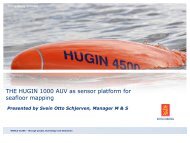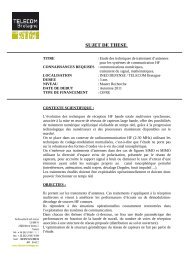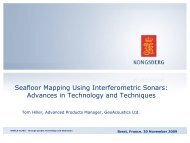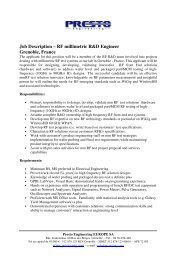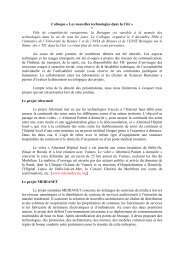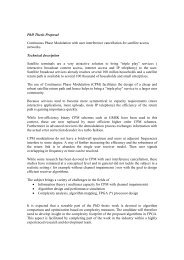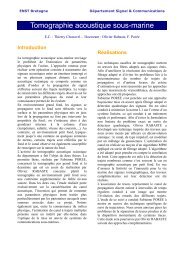Département Réseau, Sécurité et Multimédia Rapport d'Activités 2008
Département Réseau, Sécurité et Multimédia Rapport d'Activités 2008
Département Réseau, Sécurité et Multimédia Rapport d'Activités 2008
Create successful ePaper yourself
Turn your PDF publications into a flip-book with our unique Google optimized e-Paper software.
Adaptation of Multimedia Flows in a Seamless Mobility ContextResearch Staff : Jean-Marie Bonnin – Ph.D. Student: Dominique PichonKeywords : h<strong>et</strong>erogeneous access n<strong>et</strong>works, service adaptation, seamless mobility, multimediastreamingApplications : mobile operator n<strong>et</strong>worksPartners & Funding : CIFRE France Telecom R&DIntroductionIn the past few years several techniques havebeen designed in order to enable sessioncontinuity during mobility events. Neverthelesssuch events often entail long-term effects onthe terminal execution environment, which canresult in severe repercussions on services asusual as the video streaming.This work aims at proposing, simulating andimplementing a generic architecture that wouldallow any kind of services to face with mobilityevents. During the first part of this work acomprehensive survey has been achieved anda first version of a new architecture has beendesigned, which is currently under evaluation.AchievementsA survey of works dealing with serviceadaptation in the mobile n<strong>et</strong>work context havebeen achieved. Its conclusions led us to definea generic architecture complying with the NextGeneration N<strong>et</strong>work paradigm. This model iscurrently used as a basis to specify, simulateand implement simple scenarios to show offthe potential advantages of the proposedgeneric architecture.Services, such as multimedia streaming,require specific architecture to run inh<strong>et</strong>erogeneous environment. Usually QoSarchitectures are implemented to guarantee acertain level of performance, which mayinclude adaptation mechanisms, such as theones used in proxies to adapt the multimediacontent to the best achievable quality.However, mobility makes this environmentdynamic. This causes important changes in theservice environment and leads to majordisruptions in their execution.A mobility intelligence is therefore required tomanage complex decisions such as the choiceof the best datapath in the operator n<strong>et</strong>work.In a similar way a service intelligence is alsoneeded as well to analyze the service runningenvironment (e.g., user profiles and so on)and to d<strong>et</strong>ermine the way a service should runto allow the best user experience. Theseintelligences are distributed from the source tothe terminal, including any entity taking part tothe service and should closely collaborate astheir decisions are linked.The adaptation architecture must becompatible with any service platform. In thiscontext, the IP Multimedia Subsystemrepresents a good candidate to d<strong>et</strong>ermine theadaptation chain throughout its lif<strong>et</strong>ime fromthe service negotiation to its invocation andexecution. The adaptation architecture shouldnot be tied to any mobility protocols, but itcould take this factor into account, for instanc<strong>et</strong>o d<strong>et</strong>ermine the adaptation entity localization.These conclusions resulted in a genericarchitecture, wherein a mobility manager anda service manager dedicated to the sessionmanagement work tog<strong>et</strong>her in order toaccurately adapt a service according to itsruntime execution environment. Thisarchitecture and its motivations are d<strong>et</strong>ailed ina paper to be presented at HET-NETS'08 [1].Future worksThis model has also been used to specify ademonstration that will show a basicadaptation of a scalable video in a reaction tohandovers b<strong>et</strong>ween h<strong>et</strong>erogeneous n<strong>et</strong>works,such as WiFi and UMTS.Extensive simulation works (under OPNET)have been planed to demonstrate the interestof the proposed architecture and to propos<strong>et</strong>ypical deployment.Reference[1] Dominique Pichon, Karine Guillouard,Pierrick Seité, Jean-Marie Bonnin, HET-NETS'08, "Adaptation of Multimedia Flows in aSeamless Mobility Context Using OverlayN<strong>et</strong>works", February <strong>2008</strong>24 Extract of Pracom’s Annual Report <strong>2008</strong>



